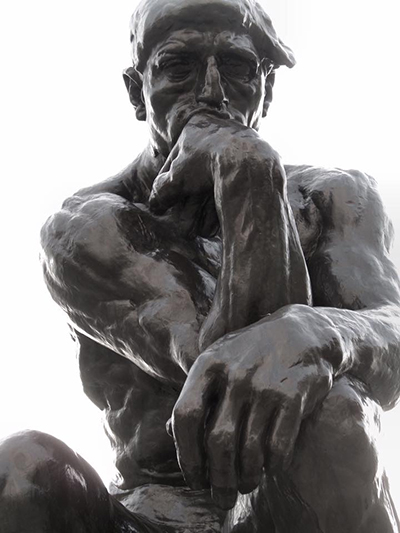The Thinker, Le Penseur, is considered by many art historians to have been Auguste Rodin's most famous sculpture, and its success has led to numerous castings of the original being made up for numerous clients across the world.
Auguste Rodin is one of the few sculptors to be famous outside of the immediate world of this skillful medium. His name and artistic reputation can be placed alongside the likes of Michelangelo, Gian Lorenzo Bernini and Constantin Brancusi for contribution to this complex art form. Painters have always been held in greater public affection than sculptors but these fine artists have managed to overcome these obstacles and create names that will be remembered forever.
The iconic image seen in this sculpture is of a male figure perched on some rock, gently reflecting whilst deep in thought. He balances his chin on one hand which communicates to the viewer his state of mind. There are currently, at the time of writing, around 28 castings of the original around the world. Some were not produced by the artist himself, or even under his supervision, and so the quality across this selection of sculptures varies considerably. Smaller versions are also in existence, as are versions in other materials, such as plaster (the original was in Bronze).
Le Penseur, or The Thinker, was actually originally known as The Poet. It was intended to be a part of Rodin's Gates of Hell but was later developed into a separate artwork. This was the case with several other pieces which didn't quite fit the theme of this large project, but were still much loved by the artist and who considered them worthy of being developed into completed sculptures. The sculptor decided that this new piece would best be viewed from below so most versions of it will be placed high up on a plinth in order match the artist's original wishes.
The subject in this sculpture is believed to not just be contemplating life but also perhaps peering over to peer at the circles of Hell. That fits in with the inspiration of Dante's Divine Comedy, a piece of literature which also inspired the likes of Sandro Botticelli during the Italian Renaissance. Many other theories have also been put forward over the years from established art historians, but this explanation seems to be the most likely. In terms of existing sculptures that may have influenced Rodin in how he put this scene together, many point to Carpeaux's Ugolino (1861) and to a portrait of Lorenzo de' Medici from Michelangelo in around 1526-31. A quick comparison between the three statues would certainly suggest the possibility of influence on the Frenchman.
Initially it is believed that the gentleman captured in the sculpture was Dante's Minos who was sit in judgement of the damned. Later the artist decided it should be Dante himself, which remains the most common view. Some then believe that The Thinker became Rodin himself, as a direct self-portrait. The importance and prominence of this sculpture has meant that considerable amounts of research has been carried out in order to confirm or deny the various theories but all we can do here is explain which we consider more likely on the balance of probability.
"...set within the quiet, enclosed space, is the figure of the Thinker, the man who sees the whole immensity and all the terrors of this spectacle because he thinks it. He sits silent and lost in meditation, heavy with visions and thoughts, and, with his whole strength (the strength of a man of action), he thinks. His whole body has become a skull and all the blood in his veins has become a brain..."
Rainer Maria Rilke, Auguste Rodin, 1902




